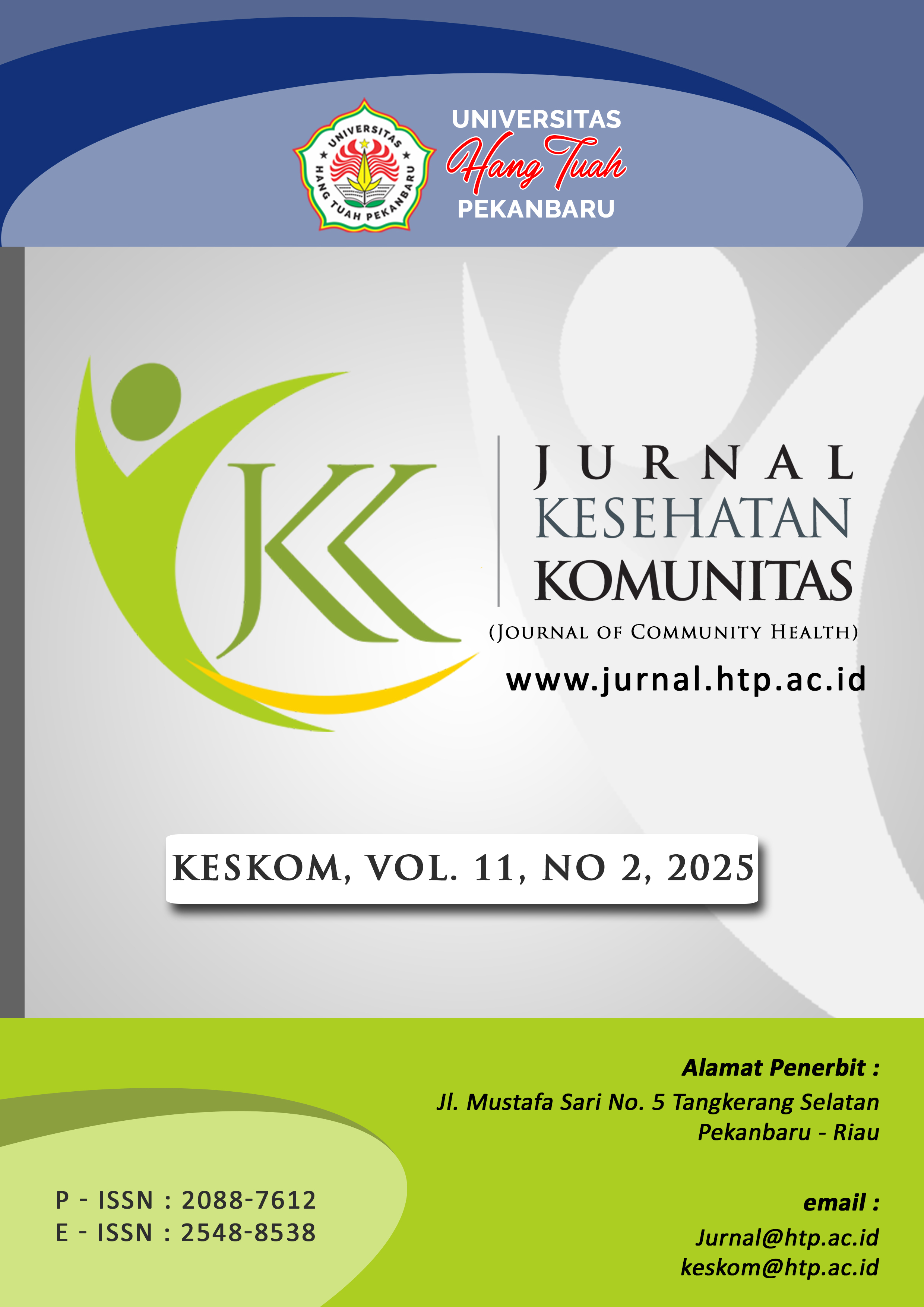Productivity of Women Workers Who are TB Survivors in Indonesia: Role of Psychological Well-Being
DOI:
https://doi.org/10.25311/keskom.Vol11.Iss2.2208Keywords:
Return to Work, Theory of Planned Behavior, Psychological Well-being, Norma SubjektifAbstract
Indonesia ranks second in the world for the highest number of Tuberculosis (TB) cases, with approximately 30% of patients being women of productive age. The lengthy TB treatment process often requires extended leave from work, which can negatively impact mental health due to social stigma and concerns about transmission. This quantitative study aims to analyze the factors influencing the intention of female TB survivors to return to work, by integrating the Theory of Planned Behavior and psychological well-being. The survey involved 238 respondents from the PETA-TB community in Jakarta, Tangerang, and Bandung. Data were analyzed using SEM-PLS with R-Studio. The results show that subjective norms positively affect both psychological well-being and return-to-work intention, while perceived health influences psychological well-being but not directly the intention to return to work. Psychological well-being is confirmed as a key mediating factor between social support and the intention to return to work.
Downloads
References
UNOPS. Engage & Empower: Supporting People on TB treatment to identify and overcome barriers to accessing TB services. 2020.
2. International Labour Organization (ILO). Perawatan pada Pekerjaan di Indonesia: Berinvestasi pada cuti dan layanan perawatan untuk dunia. 2022;1–10.
3. Spasova S, Bouget D, Vanhercke B. Sick pay and sickness benefit schemes in the European Union. Luxembourg: European Commission; 2016. 42 p.
4. Floderus B, Göransson S, Alexanderson K, Aronsson G. Self-estimated life situation in patients on long-term sick leave. J Rehabil Med. 2005;37(5):291–9.
5. Kementerian Kesehatan Republik Indonesia. Strategi Nasional Penanggulangan Tuberkulosis di Indonesia 2020–2024. Jakarta: Kemenkes RI; 2020. p. 135.
6. Steenstra IA, Lee H, De Vroome EMM, Busse JW, Hogg-Johnson SJ. Comparing current definitions of return to work: A measurement approach. J Occup Rehabil. 2012;22(3):394–400.
7. Mikkelsen MB, Rosholm M. Systematic review and meta-analysis of interventions aimed at enhancing RTW for sick-listed workers with common mental disorders, stress-related disorders, somatoform disorders and personality disorders. Occup Environ Med. 2018;75(9):675–86.
8. de Vries H, Fishta A, Weikert B, Rodriguez Sanchez A, Wegewitz U. Determinants of sickness absence and RTW among employees with common mental disorders: A scoping review. J Occup Rehabil. 2018;28(3):393–417.
9. Andersen MF, Nielsen KM, Brinkmann S. Meta-synthesis of qualitative research on RTW among employees with common mental disorders. Scand J Work Environ Health. 2012;38(2):93–104.
10. Ajzen I. The theory of planned behavior. Organ Behav Hum Decis Process. 1991;50(2):179–211.
11. Anindita R, Korompis VN. Telework, well-being, stress, and productivity during COVID-19 pandemic: Does women's resilience matter? J Apl Manaj. 2022;20(3):389–96.
12. Anindita R, Lukito L, Amalia L. Teachers and technostress during COVID-19 pandemic: A modification of technology acceptance model. In: Proceedings of the 6th International Conference on Education and Technology (ICET 2022). Atlantis Press; 2023. p. 237–49.
13. Efendi R, Anindita R. The role of proactive coping and future time orientation on perceived work productivity in generations Y and Z. Indones J Bus Entrep. 2022;8(2):229–39.
14. Prang KH, Bohensky M, Smith P, Collie A. RTW outcomes for workers with mental health conditions: A retrospective cohort study. Injury. 2016;47(1):257–64.
15. Nigatu YT, Liu Y, Uppal M, McKinney S, Gillis K, Rao S, Wang J. Prognostic factors for RTW of employees with common mental disorders: A meta-analysis of cohort studies. Soc Psychiatry Psychiatr Epidemiol. 2017;52(10):1205–15.
16. Dunstan DA, Covic T, Tyson GA. What leads to the expectation to return to work? Insights from a Theory of Planned Behavior (TPB) model of future work outcomes. Work. 2013;46(1):25–37.
17. Cooke R, Dahdah M, Norman P, French DP. How well does the theory of planned behaviour predict alcohol consumption? A systematic review and meta-analysis. Health Psychol Rev. 2016;10(2):148–67.
18. McDermott MS, Oliver M, Svenson A, Simnadis T, Beck EJ, Coltman T, et al. The theory of planned behaviour and discrete food choices: A systematic review and meta-analysis. Int J Behav Nutr Phys Act. 2015;12:162.
19. Goldberg DP, Oldehinkel T, Ormel J. Why GHQ threshold varies from one place to another. Psychol Med. 1998;28(4):915–21.
20. Francis JJ, Eccles MP, Johnston M, Walker A, Grimshaw J, Foy R, et al. Constructing questionnaires based on the theory of planned behavior: A manual for health services researchers. Newcastle upon Tyne: Centre for Health Services Research, University of Newcastle; 2004. p. 51–79. 21–37:
21. Wasiak R, Young AE, Roessler RT, McPherson KM, Van Poppel MNM, Anema JR. Measuring return to work. J Occup Rehabil. 2007;17(4):766–81.
22. Ryff CD. Happiness is everything, or is it? Explorations on the meaning of psychological well-being. J Pers Soc Psychol. 1989;57(6):1069–81.
23. Sánchez-López MDP, Dresch V. The 12-item General Health Questionnaire (GHQ-12): Reliability, external validity and factor structure in the Spanish population. Psicothema. 2008;20(4):839–43.
24. Holi MM, Marttunen M, Aalberg V. Comparison of the GHQ-36, the GHQ-12 and the SCL-90 as psychiatric screening instruments in the Finnish population. Nord J Psychiatry. 2003;57(3):233–8.
25. Conner M, Norman P. Predicting and changing health behaviour: Research and practice with social cognition models. 3rd ed. London: McGraw-Hill Education; 2015.
26. Ryff CD, Singer B. The contours of positive human health. Psychol Inq. 1998;9(1):1–28.
27. Armitage CJ, Conner M. Efficacy of the Theory of Planned Behaviour: A meta-analytic review. Br J Soc Psychol. 2001;40(Pt 4):471–99.
28. Santiago-Pérez MI, Pérez-Ríos M, Malvar A, Hervada X. Influence of response options on self-perceived health status. Int J Public Health. 2019;64(8):1247–9.
29. OECD/European Observatory on Health Systems and Policies. Improving healthcare quality in Europe: Characteristics, effectiveness and implementation of different strategies. Copenhagen: WHO Regional Office for Europe; 2019.
30. Ryff CD, Keyes CLM. The structure of psychological well-being revisited. J Pers Soc Psychol. 1995;69(4):719–27.
31. Cortinovis C, Olsson P, Boke-Olén N, Hedlund K. Scaling up nature-based solutions for climate-change adaptation: Potential and benefits in three European cities. Urban For Urban Green. 2022;67:127450.
32. Voss M. Psychological status and work rehabilitation outcomes. Am J Occup Ther. 2023;77(Suppl 2):7711505173p1.
33. Brouwer S, Krol B, Reneman MF, Bültmann U, Franche RL, Van der Klink JJL, et al. Behavioral determinants as predictors of RTW after long-term sickness absence: An application of the Theory of Planned Behavior. J Occup Rehabil. 2009;19(2):166–74.
34. Stam K, Sieben I, Verbakel E, de Graaf PM. Employment status and subjective well-being: The role of the social norm to work. Work Employ Soc. 2016;30(2):309–33.
35. Young AE, Roessler RT, Wasiak R, McPherson KM, Van Poppel MNM, Anema JR. A developmental conceptualization of return to work. J Occup Rehabil. 2005;15(4):557–68.
36. Hedlund J, Carlsen H, Croft S, West C, Bodin Ö, Stokeld E, et al. Impacts of climate change on global food trade networks. Environ Res Lett. 2022;17(12):125005.
37. Tjulin Å, MacEachen E, Ekberg K. Exploring workplace actors’ experiences of the social organization of return-to-work. J Occup Rehabil. 2010;20(3):311–21. ...
38. Vestling M, Tufvesson B, Iwarsson S. Indicators for RTW after stroke and the importance of work for subjective well-being and life satisfaction. J Rehabil Med. 2003;35(3):127–31.
39. Leite Â, Ramires A, de Moura A, Souto T, Marôco J. Psychological well-being and health perception: Predictors for past, present and future. Rev Psiquiatr Clin. 2019;46(3):53–60.
40. Stanyte A, Podlipskyte A, Milasauskiene E, Király O, Demetrovics Z, Ambrasas L, et al. Mental health and wellbeing in Lithuanian medical students and resident doctors during COVID-19 pandemic. Front Psychiatry. 2022;13:1–7.
41. Lee KS, Feltner FJ, Bailey AL, Lennie TA, Chung ML, Smalls BL, et al. The relationship between psychological states and health perception in individuals at risk for cardiovascular disease. Psychol Res Behav Manag. 2019;12:317–24.
42. Kohls E, Guenthner L, Baldofski S, Brock T, Schuhr J, Rummel-Kluge C. Two years COVID-19 pandemic: Development of university students’ mental health 2020–2022. Front Psychiatry. 2023;14.
43. Hinoveanu D, Anastasiu DM, Citu C, Crisan DC, Popa ZL, Nicolae N, et al. Mental health and contraceptive knowledge in high schoolers: Comparing remote and in-person learning during COVID-19. Med. 2023;59(10):1–12.
44. Iversen V, Sam D, Helvik A. Psychological distress and perceived health in inmates in Norwegian prisons. Scand J Public Health. 2014;42(2):171–6.
45. Shields M, Shooshtari S. Determinants of self-perceived health. Health Rep. 2001;13(1):35–52.
46. Vasileva IV, Chumakov MV. Dynamics of subjective student wellbeing during the COVID-19 pandemic. Ekol Cheloveka. 2022;29(9):643–51.
47. Neill RD, McFadden P, Manthorpe J, Mallett J, Currie D, Schroder H, et al. Changing responses during the COVID-19 pandemic: A comparison of psychological wellbeing and work-related quality of life of UK health and social care workers. BioMed. 2023;3(3):369–86.
48. Wettstein M, Nowossadeck S, Vogel C. Well-being trajectories of middle-aged and older adults and the Corona pandemic: No “COVID-19 effect” on life satisfaction, but increase in depressive symptoms. Psychol Aging. 2021;37(2):175–89.
49. Blanchflower DG, Bryson A. Were COVID and the Great Recession well-being reducing? SSRN Electron J. 2023.
50. Cao Y, Lü J. Subjective health perception indicators among elderly living at home: A covariance structure analysis. Estuar Coast Shelf Sci. 2020;240:473–84.
51. Karamushka LM, Kredentser OV, Tereshchenko KV, Delton Y, Arefniya SV, Paskevska IA. Subjective well-being of different groups of population during the 2022 war in Ukraine. Wiad Lek. 2022;75(8):1854–60.
52. Sampere M, Gimeno D, Serra C, Plana M, Lopez JC, Martínez JM, et al. RTW expectations of workers on long-term non-work-related sick leave. J Occup Rehabil. 2012;22(1):15–26.
53. Magnavita N, Soave PM, Antonelli M. A one-year prospective study of work-related mental health in the intensivists of a COVID-19 hub hospital. Int J Environ Res Public Health. 2021;18(18):1–14.
54. Schuring M, Mackenbach J, Voorham T, Burdorf A. The effect of re-employment on perceived health. J Epidemiol Community Health. 2011;65(7):639–44.
55. Syunyakov T, Zorkina Y, Ochneva A, Abramova O, Savenkova V, Alekseeva P, et al. Comparison of anxiety and depression rates in Russian health care professionals in 2020 and 2023. Psychiatr Danub. 2023;35:296–301.
56. Løvvik C, Shaw W, Øverland S, Reme SE. Expectations and illness perceptions as predictors of benefit recipiency among workers with common mental disorders: Secondary analysis from a randomized controlled trial. BMJ Open. 2014;4(3):1–9.
57. Rueda S, Chambers L, Wilson M, Mustard C, Rourke SB, Bayoumi A, et al. Association of returning to work with better health in working-aged adults: A systematic review. Am J Public Health. 2012;102(3):541–56.
58. Shaw L, Segal R, Polatajko H, Harburn K. Understanding RTW behaviours: Promoting the importance of individual perceptions in the study of return to work. Disabil Rehabil. 2002;24(4):185–95.
59. Figueredo JM, García-Ael C, Gragnano A, Topa G. Well-being at work after RTW: A systematic review. Int J Environ Res Public Health. 2020;17(20):1–27.
60. Vestling M, Tufvesson B, Iwarsson S. Indicators for RTW after stroke and the importance of work for subjective well-being and life satisfaction. J Rehabil Med. 2003;35(3):127–31.
61. Berger-Estilita J, Abegglen S, Hornburg N, Greif R, Fuchs A. Health-promoting quality of life at work during the COVID-19 pandemic: A 12-month longitudinal study on the work-related sense of coherence in acute care healthcare professionals. Int J Environ Res Public Health. 2022;19(10):1–14.
62. Sinval J, van Veldhoven M, Oksanen T, Azevedo LF, Atallah ÁN, Melnik T, et al. Interventions for improving recovery from work. Cochrane Database Syst Rev. 2021;2021(12):1–73.
63. Abbott A. The coping strategy questionnaire. J Physiother. 2010;56(1):63.
64. Ma Y, Li Y, Han F. Interconnected eco-consciousness: Gen Z travelers’ intentions toward low-carbon transportation and hotels. Sustain. 2024;16(15).
65. Abdillah W, Hartono J. Partial least square (PLS): Alternatif structural equation modeling (SEM) dalam penelitian bisnis. Yogyakarta: Andi; 2015. p. 22, 103–50.
66. Sekaran U. Metodologi penelitian untuk bisnis. 4th ed. Jakarta: Salemba Empat; 2006.
Downloads
Submitted
Accepted
Published
How to Cite
Issue
Section
License
Copyright (c) 2025 Jurnal kesehatan komunitas (Journal of community health)

This work is licensed under a Creative Commons Attribution-NonCommercial-ShareAlike 4.0 International License.
Copyright @2017. This is an open-access article distributed under the terms of the Creative Commons Attribution-NonCommercial-ShareAlike 4.0 International License (http://creativecommons.org/licenses/by-nc-sa/4.0/) which permits unrestricted non-commercial used, distribution and reproduction in any medium












































